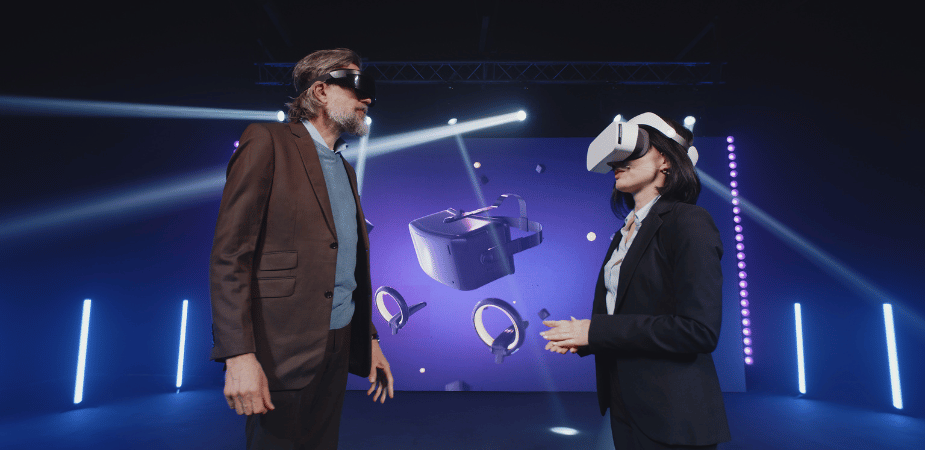- April 04, 2025 3:14 pm
- by Kevin
- April 04, 2025 3:14 pm
- by Manek

Over the past few years, Augmented Reality has moved from being a technological novelty to a mainstream marketing tool, with big brands incorporating it into their campaigns. According to industry experts, AR will continue to gain traction in advertising, with estimates suggesting that the global AR market will reach a valuation of USD 140.34 billion in 2025 to USD 1,716.37 billion by 2032, exhibiting a CAGR of 43.0% during the forecast period. This growth is driven by the increasing accessibility of AR technology, the proliferation of smartphones equipped with AR capabilities, and the increasing demand for innovative and interactive marketing solutions.
In this article, we will explore how AR is changing the landscape of marketing and advertising, the benefits it brings to brands, the challenges it faces, and some of the most innovative examples of AR being used in marketing campaigns today.
The integration of AR in marketing strategies can be traced back to the early 2010s, when mobile apps such as Pokémon Go demonstrated AR’s vast potential to engage users. However, the idea of AR in advertising is far older. In fact, AR technology has been around since the 1990s, but it wasn’t until smartphones became ubiquitous and AR apps became more sophisticated that it really started to be used in marketing campaigns.
Today, companies are using AR to create experiences that merge the digital world with physical reality. With the rise of AR, marketing has shifted away from traditional advertising methods such as static billboards, print ads, or TV commercials toward more immersive, engaging content. Nowadays, tech-savvy consumers crave personalized and immersive experiences, and AR provides exactly that.
Enhanced Customer Engagement: Whether it’s allowing users to "try on" a product virtually or interact with a brand mascot in a 3D environment, AR makes advertising a fun and engaging experience. The novelty of AR also makes users more likely to share these experiences on social media, amplifying brand awareness.
Increased Product Understanding and Education: By giving customers an interactive preview of how a product will fit into their daily lives, AR can reduce the chances of returns and improve customer satisfaction.
Personalized and Targeted Experiences: With AR, consumers can see how products look on them in real time, leading to better-informed purchase decisions and a more personalized shopping experience. By harnessing AR technology, brands can use customer data to provide relevant product recommendations and targeted ads based on user behavior.
Building Brand Loyalty and Trust: By offering innovative experiences, such as AR-powered games, digital rewards, or virtual brand experiences, companies can create lasting impressions that strengthen brand loyalty.
Cost-Effective Advertising: Traditional forms of advertising, such as TV commercials or print ads, often require significant investment in production and distribution. AR, on the other hand, can be distributed through mobile apps or social media platforms, offering a more cost-efficient way for brands to reach their target audience. Moreover, AR can have a longer lifespan than a typical ad campaign, as consumers can revisit and share AR experiences, ensuring the content continues to generate value.
IKEA's AR App: The app lets customers use their smartphones to see how furniture will look in their homes before making a purchase. This AR experience helps customers visualize how products fit in their spaces and gives them confidence in their purchase decisions.
Sephora's Virtual Makeup Try-On: Using the app, shoppers can virtually try on makeup products to see how different shades of lipstick, foundation, and eyeshadow will look on their skin tone. This AR tool has not only improved the online shopping experience but also reduced the risk of returns by allowing customers to make more informed purchasing decisions.
L'Oreal's AR Beauty App: This tool allows customers to upload photos of themselves and use augmented reality to try on different products in real time. By combining AR with advanced beauty AI, L'Oréal offers a seamless, personalized, and highly engaging shopping experience for beauty enthusiasts around the world.
Pepsi’s AR Bus Shelter Ad: In 2014, Pepsi launched an AR-powered advertisement at a bus shelter in London, where commuters were in for a surprise. The ad used AR to transform the bus shelter into a digital screen showing dramatic and humorous scenarios, such as an alien spaceship landing or a tiger jumping out. This innovative use of AR turned a routine experience into something extraordinary, garnering massive media attention and creating a buzz on social media.
Coca-Cola's AR Campaigns: The company introduced an interactive billboard that allowed people to participate in an AR game. This unique approach to advertising enhanced the customer experience, encouraged interaction, and showcased how AR can be leveraged to connect consumers with brands in exciting and novel ways.
As augmented reality continues to evolve, it’s clear that it will play an increasingly important role in the marketing and advertising world. Brands are recognizing the potential of AR to create more engaging, personalized, and immersive experiences for their customers. From virtual try-ons to interactive ads, AR is helping businesses reach their audiences in new and innovative ways. The continued development of AR technology, along with the increasing use of mobile devices and wearable tech, promises to open up even more possibilities for marketers. For businesses looking to leverage AR in their marketing strategies, working with experts in AR development and digital marketing can be a game-changer. Vofox offers top-tier AR development and marketing services, helping companies create impactful, interactive experiences that resonate with modern consumers. Don’t hesitate to reach out to us at any time to learn more.
Guaranteed Response within One Business Day!

Custom Software Development: When to Build vs Buy
Code Review Best Practices That Actually Work in 2025

GitHub Copilot vs Other AI Coding Assistants

Sustainable Software Development Practices

What is a Convolutional Neural Network (CNN)?